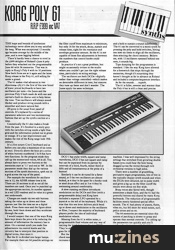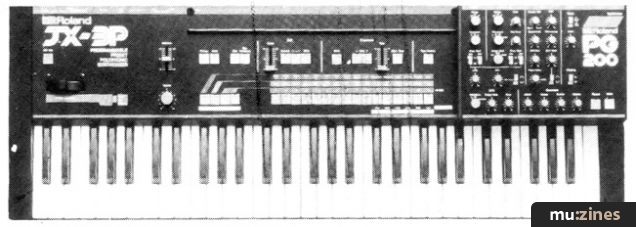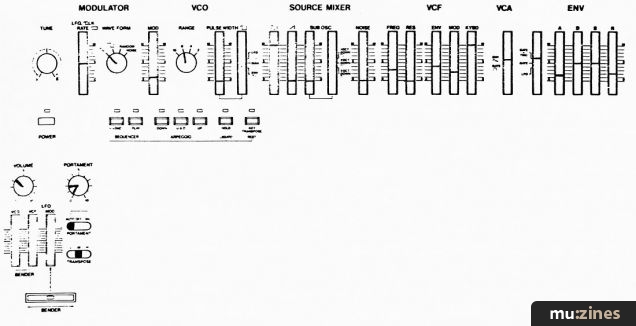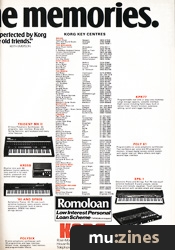Magazine Archive
Home -> Magazines -> Issues -> Articles in this issue -> View
Korg Poly 61 | |
Article from One Two Testing, December 1982 | |
Shake with disbelief as you find out Korg have produced a 12 oscillator, 64 memory polyphonic for under a grand.

The leaps and bounds of synthesiser technology never allow you to stay satisfied for long. What was exceptional 12 months ago became average by the middle of the year, and is now lagging behind.
There'd hardly been a chance to revel in the £699 delights of Roland's Juno 6 poly before they whacked out the programmable Juno 60 with 56 memories. That was in reply to Korg's Poly 6 with its 32 positions. Now both firms are at it again and the latest Korg release is the Poly 61, still selling for under a grand.
The 61 makes vital advances in two directions — (A) it's the first of this new breed of lower priced keyboards to have two oscillators per note — the Junos and the previous Poly 6 both made do with one and carried a built-in chorus unit to help fatten the tone. Two oscillators will always sound thicker and produce string sounds with a smoother and more natural feel.
(B) gone is the usual front panel of controls. It's replaced by a series of parameter selectors and two incrementing buttons that set up the synth a section at a time.
Cosmetically the 61 also makes a break from the past. It's finished in a steely grey with the switches sitting inside a light blue grid and the information picked out in green or orange. It's a vast improvement and makes the rest of the Korg range look 19th century.
It's a five octave C-to-C keyboard and as before you can play a maximum of six notes at once. Directly above the keys are a series of white buttons numbered 1 to 8 that have two functions. In the program mode they call up the memorised voices, 64 in all. You always have to press two buttons so the memories start at '11' and end at '88'. In the parameter mode they dial up the various sections of the synth electronics, spelt out in a grid across the top of the panel.
For example the waveform for oscillator one is 12, the ADSR release time is 44. There are 20 sections in all as not all the numbers are used. Once you've punched up the appropriate section, its number appears in a red LED readout and its value in a green one underneath.
Changes are made via two edit buttons taking the value up or down and these operate just like the time set on a digital clock. Press them once and the figure alters by one, hold them down and they accelerate through the scale.
I would suspect that one of the ways Korg have kept down the price is by reducing the amount of information the memory has to store. On a normal synth you make fine adjustments via control knobs and the circuitry has to interpret that position in digital terms, then store it.
But the 61 is divided into larger lumps. For example there are 64 possible settings on the filter cutoff from maximum to minimum, but only 16 for the attack, decay, sustain and release time, eight for the resonance and envelope generator amount. So the 61 is not capable of those fine adjustments in between the numbers that control knobs could produce.
In practice it's not a great problem, but might occasionally irritate in the studio where you couldn't get just the right release time, particularly on string settings.
The oscillators are both DCOs — digitally rather than voltage controlled — which makes no detectable difference in tone, but ensures they tune up faster and don't wander. The Junos apply the same technique.
DCO 1 has pulse width, square and ramp waveforms, DCO 2 has just square and ramp but can be separated from its partner by intervals of a third, fourth, minor third or fifth and all instantaneous at the press of a button!
Similarly it can be de-tuned for a fatter sound, at 0 the two oscillators are almost locked, at 6 they're far apart for a honky tonk or steel drum effect and at 3 or 4 they're swimming around comfortably.
A slow running oscillator introduces modulation on the DCOs and filter (with a programmable delay) and Korg have included a separate LFO operated by a joystick to the left of the keyboard. While it's true that this one lever delivers pitch bend up or down and modulation to the oscillators or filter, I suspect the majority of keyboard players prefer the idea of individual modulation wheels.
Missing from the 61 is white noise, a programmable final volume and any way of varying the levels between the two DCOs. They're either full on, or off and the same goes for the keyboard tracking.
But the bonuses are an arpeggiator, a chord memory that stores a shape then recreates it each time a fresh note is pressed, and a hold to sustain a sound indefinitely. The 61 can be converted to a mono synth by pressing the poly and hold switches, hitting one note six times to align all the oscillators, then selecting the chord memory. Believe me, with 12 oscillators rammed behind one note, it sounds big.
Tape dumping for the programmes is standard. I like the way Korg have allowed for a footswitch that steps through the memories, though it's surprising they haven't thought as far in advance as Roland and included a computer/sequencer interface.
As for the sounds... superb.
The 61 is fuller, sweeter and warmer than the Poly 6 but is still a clean and precise machine. I was well impressed by the string settings that stretched from growling double basses (you could hear the bow being dragged across the wires) through rich orchestral versions to high solos.
There were a number of grumbling, percussive organ programmes, lots of bite in the typically choppy synth sounds and when the DCOs were detuned, set to pulse width and given a leg up on the filter cutoff the results were about ten feet wide.
Brass voices also faired well, though sometimes a shade fizzy, and the 61 had the powerful bottom end shared by many Korg keyboards. The reduction of programmable facilities mostly hindered special effect sounds. The 61 had plenty of pianos, flutes, vibes etc, but fell short for wind noises, surf, police sirens and so on.
The 64 memories are essential since this system of patching is slower to grasp and operate than normal controls. Try calling up the parameters too quickly and you'll confuse the electronics with fumbling fingers.
But once you're there, the 61 is going to take a lot of beating.
R.R.P £999 inc VAT
Enquiries: Rose-Morris, (Contact Details).
Also featuring gear in this article
Korg Poly 61
(EMM Mar 83)
Polyphonic Synthesizers
(ES Dec 83)
Patchwork
(EMM Jan 84)
...and 2 more Patchwork articles... (Show these)
Browse category: Synthesizer > Korg
Publisher: One Two Testing - IPC Magazines Ltd, Northern & Shell Ltd.
The current copyright owner/s of this content may differ from the originally published copyright notice.
More details on copyright ownership...
Review
Help Support The Things You Love
mu:zines is the result of thousands of hours of effort, and will require many thousands more going forward to reach our goals of getting all this content online.
If you value this resource, you can support this project - it really helps!
Donations for May 2024
Issues donated this month: 0
New issues that have been donated or scanned for us this month.
Funds donated this month: £0.00
All donations and support are gratefully appreciated - thank you.
Magazines Needed - Can You Help?
Do you have any of these magazine issues?
If so, and you can donate, lend or scan them to help complete our archive, please get in touch via the Contribute page - thanks!









